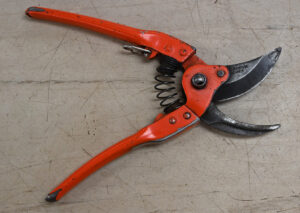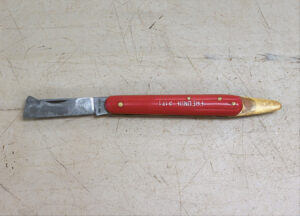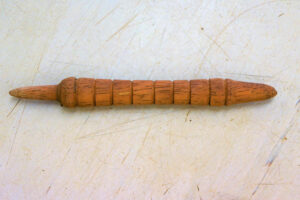The propagator’s arsenal – tools of the trade
By Dan Austin
When talking tools for plant propagation, there is no doubt people will have their favourites, not only brands, but gadgets and home engineered hacks. So, if you are coming in green to the industry, it is worth knowing about a few tools of the trade.
The tools in the propagator’s arsenal are many, and in the case of the propagation technique of division, can be as simple as a sharp spade. Whether it is a rhubarb crown, a clump of iris rhizomes or an aggregate of agapanthus, a sharp spade is invaluable to cut through the material in order to multiply the plants. A hose and high-pressure nozzle are also a good idea to wash away excess soil from plant roots, both for good hygiene and to make the material easier to work with.
Division has got to be about the simplest form of propagation there is, but from there the techniques and tools involved become more complex. Even seed propagation is not always simple and trying to germinate seed with built-in dormancy mechanisms might see you heading to the kitchen, rather than the garden. The refrigerator is a useful way to chill or ‘stratify’ seed that requires cold treatment, while soaking seed with a kettle of hot water, one minute off the boil, is a useful way to treat seed to encourage germination of a range of hard-coated species. Beware, waiting that one minute off the boil is important to ensure you don’t accidentally cook your seed.

While hot water treatment is common practice to encourage seed to take in water through tough seed coats, scarification is a mechanical means to achieve a similar result. Scarification can be achieved by simply rubbing seed between sheets of sandpaper, though more precise results can be achieved by nicking seed coats with a sharp blade, so it is not uncommon for propagators frequently working with this type of seed to invest in tweezers, a scalpel and even a microscope.
When it comes to processing vegetative propagation material and setting cuttings, a good pair of secateurs are your best friend. Propagation snips are preferred by some, as they have two blades, almost like scissors, and do not tend to crush plant material when kept sharp, but they do not often have the strength or design to process hardwood material. A good pair of secateurs that are well maintained and kept sharp will also minimise bruising and allow you to process material less than a millimetre thick through to stems thicker than your fingers. You can feel the quality when holding a good pair of secateurs, and without recommending any particular brand, you largely get what you pay for with this particular tool. The more expensive options have various designs so you can match them to your hand size and whether you are left or right-handed, they hold an edge on the blade longer and generally allow you to replace any lost or damaged parts. Invest in the right pair of secateurs and you can have them for life.
Another understated important tool when setting cuttings is the trusty ‘dibber’, ‘dibbler’ or ‘dibble stick’, depending on what text you read or who taught you. Basically, a dibble stick is used to create the hole in your propagation medium before you insert your plant material. They can be useful to ensure uniform depths when sowing seed but are particularly important when setting cuttings. With some cuttings, you can snap a stem off a plant with bare hands, throw it at the ground and it will take root, but others require more care. When processing cuttings, sharp, sterilised secateurs are used to create clean cuts with minimal damage to the material. If the cuttings are then forced into a propagation medium without the use of a dibbler, the abrasive action of pushing the stem through the media particles can cause unseen damage to the wound, compromising the rooting of the cutting. A dibble stick can be anything from a piece of cutlery to a knitting needle but ideally would be made from material that can be sterilised between uses.

When it comes to budding and grafting, the tools involved are more diverse again. Traditionally, a budding/grafting knife and grafting tape allowed you to take desirable material from one plant and implant it onto the desirable parts of another (matching scion and rootstock material). There are all sorts of grafting tools now on the market that eliminate the risk of cuts associated with knives, however, they come in various qualities and once the blades have dulled, they are often difficult to resharpen or replace. A good grafting knife is a good, if not better, option than many of the modern tools. When kept sharp and used correctly they are a very safe piece of equipment. The blade should never be pulled towards the rest of your hand when making cuts. Your hand should move as one with the blade and when needing to exert pressure to cut into woody material you should use the joint of your thumb to pivot, creating a fulcrum effect moving the knife and your entire hand, rather than pulling the knife towards your thumb.
Grafting knives are also useful for other propagation techniques like aerial layering, where they can be used to wound the cambium layer on stems to encourage root growth. As in the case of secateurs, you get what you pay for with grafting knives and there are a few handy features worth looking for when investing in a purchase. Bark peelers and wedges are valuable features of some knives, while knives with a single bevel ensure that one side of the cut is always perfectly straight which helps to minimise bruising. For the thousands of plants they will make possible, there really doesn’t need to be a lot of tools in the propagator’s arsenal, though there are plenty of other tools out there to explore that just might make life easier. Whatever your propagation endeavours, do your research, buy smart and you’ll likely only need to buy once.
Daniel Austin
IPPS Member and Lecturer
M: 049 122 8591
F: BeyondGreenAustralia
Author: Off the Garden Path –
Green Wonders of the World

